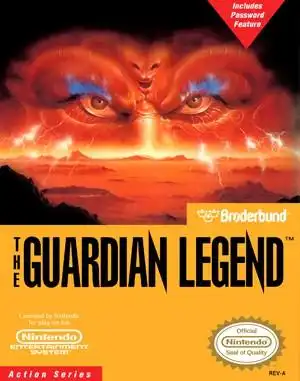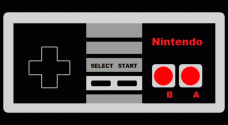If you spent any time with the Nintendo Entertainment System back in the day, you might have stumbled upon a game that felt... different. Not quite like The Legend of Zelda, not quite like Gradius, but somehow both? That, my friends, was likely The Guardian Legend NES. It's one of those titles that defied easy categorization, offering a unique blend of exploration and intense shooting action that still holds up as a fascinating piece of retro gaming history.
Released in 1988 by Compile, the wizards behind shooters like Blazing Lazers and Space Harrier ports, The Guardian Legend tasked you with infiltrating the alien planet Naju, hurtling towards Earth, to activate its self-destruct sequence. You play as the Guardian, a shapeshifting cyborg known as Miria. Sounds epic, right? It absolutely was, even if it took some players a while to figure out exactly what they were supposed to be doing.
The Genre Bender: Two Modes, One Mission
What immediately set The Guardian Legend apart was its dual gameplay structure:
- The Labyrinth: This is your top-down exploration mode. Think The Legend of Zelda, but sci-fi. You navigate interconnected rooms and corridors, talk to strange alien beings (often leaving cryptic messages), find keys, unlock doors, and search for upgrades and secrets. This is where you manage your inventory, check the map, and generally piece together the path forward.
- The Dungeons: Step onto a specific 'corridor' tile in the Labyrinth, and BAM! The game transforms into a vertical scrolling shoot 'em up. Your character morphs into a starfighter, and you blast through waves of enemies, navigating tight spaces and culminating in a boss fight. Defeating these bosses is crucial, as they often yield keys or open up new paths back in the Labyrinth.
This constant switching between modes was ambitious for the NES and kept things feeling fresh, even if it occasionally felt a little jarring or confusing until you got the hang of it.
Navigating Naju: The Map is Your Friend
One of the biggest initial hurdles for players was understanding the Labyrinth's layout and how it connected to the shooting stages. The in-game map, accessed via the Select button, was absolutely essential. It showed you the layout, your current location, and importantly, the locations of the Dungeons you needed to clear.
Exploration wasn't just about finding the next objective; it was vital for survival. Hidden rooms often contained power-ups, health refills, or even crucial secondary weapons. The game rewarded diligent searching, a stark contrast to the linear nature of many shooters at the time.
Weapons, Power-Ups, and Surviving the Onslaught
Like any good shmup or action-RPG hybrid, The Guardian Legend loaded you up with tools. You have your primary weapon (which can be powered up) and a variety of secondary weapons. These secondaries are game-changers – from wide-area blasts to powerful lasers – but they consume chips, the game's currency, which you collect from defeated enemies.
The difficulty could be uneven. Some Labyrinth sections were straightforward, while certain shooting stages or bosses felt incredibly punishing, especially if you hadn't found enough health capsules or the right secondary weapon. Mastering when to use your limited, powerful secondary weapons became key to overcoming the toughest challenges.
The Plot (Briefly)
While the gameplay takes center stage, the story provides a cool backdrop. You're the last hope, a lone cyborg sent to stop Naju. The messages left by previous failed attempts add a layer of mystery and urgency, pushing you deeper into the alien world. It's classic sci-fi pulp, perfect for the era.
Retro Challenges: Passwords vs. Savestates
Ah, the password system. A staple of many NES games, and in The Guardian Legend, it was... lengthy. Memorizing or writing down those long strings of characters was part of the retro experience, albeit a sometimes frustrating one.
Today, playing on emulators or modern collections often provides the luxury of savestates. While purists might scoff, for a game with a challenging difficulty curve and a complex map like this, savestates can make the experience much more accessible and less prone to controller-throwing frustration after a tough boss fight.
Is The Guardian Legend NES Still Worth Playing Today?
Absolutely. For retro enthusiasts, especially those who appreciate both shooters and action-adventure games, The Guardian Legend is a must-play. Its genre fusion was ahead of its time and still feels unique.
Yes, the map can be confusing initially, the password system is a relic of the past, and the difficulty spikes can be real. But the satisfaction of clearing a tough Dungeon, finding a hidden power-up in the Labyrinth, and slowly unraveling the secrets of Naju is a classic NES feeling. It's a challenging, rewarding, and genuinely interesting game that stands out in the console's vast library.
Frequently Asked Questions
Q: Is The Guardian Legend a sequel? A: Yes, it's considered a sequel to the MSX game Guardic.
Q: How do I save my progress? A: The original NES game uses a password system given by special 'Lander' items found in the Labyrinth. Modern methods like emulator savestates are often more convenient.
Q: Is the game hard? A: It can be quite challenging, especially in the vertical shooting segments and boss fights. Finding power-ups and learning enemy patterns is crucial for survival.
Q: What kind of game is it? A: It's a unique hybrid of a top-down action-adventure game (like Zelda) and a vertical scrolling shoot 'em up (shmup).
Whether you tackle it on original hardware, an emulator, or a modern collection, giving The Guardian Legend NES a try is a great way to experience a genuinely creative and challenging title from the 8-bit era. Just remember to keep that map handy!


